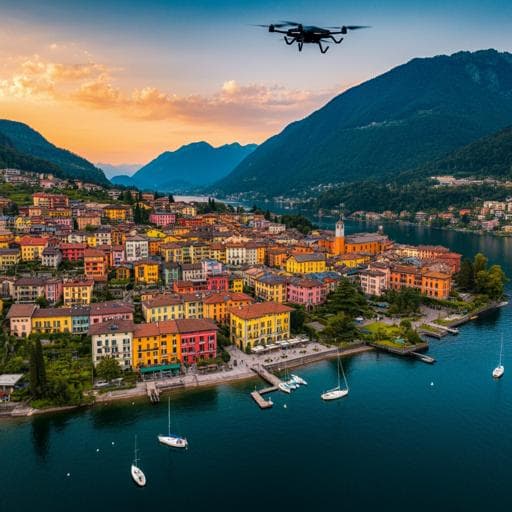
Earth Sciences
Integration and differentiation: comparison of photography behaviors using unmanned aerial vehicle data in China and Europe
X. Chen, G. Li, et al.
This intriguing study dives into the world of UAV photography, analyzing data from SkyPixel across China and Europe. Discover the emotional nuances different regions express through their photography and the fascinating hotspots shaped by human behavior and nature, researched by Xiliang Chen, Gang Li, Muhammad Sajid Mehmood, Qifan Nie, and Jie Yu.
~3 min • Beginner • English
Introduction
Consumer UAVs equipped with cameras have become popular for aerial photography, extending beyond traditional ground-based perspectives and enabling cost-effective, controllable capture of landscapes. With the rise of AI-based computer vision, large-scale image content analysis is now feasible, yet UAV user behavior in tourism remains underexplored. This study leverages SkyPixel UAV photos to compare China and Europe, aiming to characterize photographic content and preferences, emotions expressed in photo captions, and spatial distributions of UAV photography. The central research question asks: using AI-based analysis, what are the differences in photographic content, sentiment, and spatial distribution of UAV photographers between China and Europe? Understanding these differences informs destination planning and marketing and sheds light on behaviors of this growing user segment.
Literature Review
Tourism photo research has evolved from small, researcher-guided methods like visitor-employed photography (VEP) to large-scale analyses of user-generated content (UGC) on social platforms (e.g., Flickr, TripAdvisor, Pinterest). UGC overcomes VEP limitations (cost, bias, small samples) by providing scale and objectivity. Studies using Flickr/YFCC-100M metadata and geotags reveal tourist flows, hotspots, and behavioral patterns, and help distinguish tourists from residents via machine learning. Photography behavior research shows links between photography and tourism, with geotagged photos illuminating spatial-temporal use, and associations between photographing and happiness. Destination image (TDI) research highlights differences between DMO-generated and UGC images; visual content conveys affect and cognition and shapes destination perception. With AI and computer vision (e.g., Microsoft, Google APIs), image content and sentiment can be analyzed at scale. However, most prior work focuses on traditional camera/phone perspectives; UAVs add a unique aerial view, enabling access to otherwise hard-to-reach contexts and introducing new behaviors and visual content, thus warranting focused comparative research on UAV users across regions.
Methodology
Data were collected from SkyPixel (DJI’s global aerial photography community). On February 22, 2018, a web crawler retrieved items from the Explore section. Photos were manually reviewed to ensure UAV origin. A total of 1,230 geolocated photos were retained: 466 from China and 764 from Europe, contributed by 438 and 734 UAV users, respectively. Analytic components included: (1) Computer vision analysis: Using C# to call Microsoft Azure Computer Vision API to batch-process images and return tags (objects, scenes, actions). (2) Social network analysis: Content keywords (tags) were organized into co-occurrence matrices (12-by-12 categories) using VBA, then visualized in Gephi 0.92 with ForceAtlas2 to examine category associations and network structure. (3) Text sentiment analysis: Using C# and Azure Text Analytics sentiment API to score photo captions (Chinese, English, French, Spanish, etc.) on a 0–1 scale; neutral/objective captions were assigned 0.50; analyses focused on non-neutral scores (<0.50 or >0.50). (4) Spatial analysis: Kernel density estimation (KDE) was applied to geotagged photo locations to identify hotspots and spatial distribution patterns in China and Europe. The study also categorized 272 recurring image-content keywords into 12 thematic classes (adjectives, animals, characters, traffic, sports, plants, natural landscapes, human landscapes, diet, daily behavior, daily necessities, others) for comparative analysis and chi-square testing.
Key Findings
- Content emphasis and similarities: Natural landscapes dominated UAV photos in both regions (China: 27.31%; Europe: 29.84%), followed by adjectives (China: 25.51%; Europe: 25.03%). This reflects UAVs’ aerial vantage enabling expansive landscape depiction. Core photo network categories shared by both regions were daily behaviors, natural landscapes, adjectives, and traffic.
- Statistically significant differences (chi-square, p<0.01): Categories differing between regions included characters, traffic, sports, natural landscapes, human landscapes, and diet. Chinese photos had higher frequencies in traffic, human landscapes, and diet; European photos emphasized characters, sports (e.g., riding, skiing, surfing), and natural landscapes more strongly.
- Network structure: Visualized co-occurrence networks showed a core composed of daily behaviors, natural landscapes, adjectives, and traffic in both regions. In Europe, sports and characters formed a middle layer closely tied to natural landscapes; in China, characters alone occupied the middle layer, linked primarily to natural landscapes. Edge-layer categories (animals, plants, daily necessities, human landscapes, others) connected variably to the core; European networks showed stronger links between animals and natural landscapes, whereas in China the strongest edge-core link was sports–natural landscape. Diet was isolated in both regions, consistent with UAV wide-angle limitations for food imagery.
- Sentiment: From 730 captions, 414 non-neutral sentiments were analyzed. Chinese photographers tended toward neutral/central sentiment distributions, while European photographers exhibited more polarized sentiments at both extremes (0–0.29 and 0.70–1.0 bins). Negative sentiments were often associated with harsh snowy/icy conditions and uninhabited natural scenes; positive sentiments commonly involved people engaged in recreation around beaches, rivers, lakes, and blue skies/forests. Keyword associations indicated Chinese negative terms included white/smoke/covered; positive terms related to people and water bodies. European negative terms related to snow/cloudy/sunset; positive terms to people, blue skies/ocean/nature.
- Spatial patterns: China’s UAV hotspots concentrated along the southeast coast and parts of the southwest, especially in economically developed, densely populated areas east of the Hu Line. Highest/higher densities: Pearl River Delta and Yangtze River Delta urban agglomerations; high-density areas included Guilin and coastal Qingdao; medium density in midwestern Sichuan, eastern Wuhan, and the Shandong Peninsula. Europe’s coverage was more compact, with hotspots in Central and Southern Europe: highest density in central Germany; higher around southwestern Germany; low-density in western Austria, northern Italy, Switzerland; medium in Swiss–Austrian–Italian border areas and central Austria; Southern Europe concentrated in Italy with highest densities around Rome. Broader European distributions were sparse, reflecting stricter UAV regulations and localized hotspots.
- Policy context: Europe’s stricter UAV management reduces spatial connectedness of aerial photography data; China has fewer restrictions (with exceptions in central city areas like Beijing), and higher adoption in coastal, economically developed regions supports band-like hotspot distributions.
Discussion
Findings directly address the research question by identifying both shared and distinct patterns in UAV photographic content, sentiments, and spatial distributions across China and Europe. The shared core of natural landscapes, daily behavior, adjectives, and traffic indicates a convergent thematic center driven by the aerial perspective and travel contexts. Differences—greater emphasis on human landscapes/traffic in China and on characters/sports/nature in Europe—likely reflect regional cultural preferences, recreational practices, and regulatory environments. Sentiment results suggest cultural expression styles and environmental conditions (e.g., winter snow) influence affective responses, with Europe showing more polar sentiment and China clustering near neutrality. Spatially, hotspots align with mature tourist destinations near water and economically developed regions, but Europe’s stricter regulations constrain cross-regional connectivity compared to China. These insights inform tourism stakeholders and DMOs about how UAV-generated imagery can shape destination image, guide content selection for marketing, and align management with policy and safety considerations.
Conclusion
The study contributes an AI-driven comparative analysis of UAV photography behaviors in China and Europe, revealing an overarching similarity—dominance of natural landscapes—alongside statistically significant differences in several thematic categories, more neutral sentiment among Chinese photographers versus more polarized sentiment among Europeans, and distinct spatial hotspot patterns shaped by tourism development and regulation. Practical implications include leveraging UAV images for destination visual marketing, defining recommended UAV shooting areas, organizing UAV photography contests, offering rentals and short courses, and guiding safe operations. Future research directions include: adapting AI models to better recognize UAV-specific content; incorporating interviews and qualitative methods to profile UAV photographers and their social attributes; examining how evolving regulations affect UAV content and locations; focusing on pioneering UAV users’ routes and behaviors for targeted marketing; and deepening understanding of the cultural and symbolic meanings of the UAV sky perspective.
Limitations
- Regulatory dynamics: Evolving UAV policies may alter where and what users photograph; future work should assess policy impacts on content and location patterns.
- Photographer profiling: The study lacks in-depth characterization of photographers’ identities; interviews and qualitative methods are needed to distinguish UAV users from traditional photographers and explore transitions between groups.
- Social attributes and constraints: Future research should link social attributes to photography preferences and examine constraints across different user groups and purposes.
- Focus on pioneering users: Analyzing representative pioneering UAV photographers’ content, routes, and behaviors can inform tailored visual marketing strategies.
- Environmental/contextual factors: Investigate how objective environmental factors across regions influence UAV photography.
- Method enhancements: Improve computer vision and sentiment models’ adaptability to UAV imagery and captions to boost recognition of specific content and nuances.
- Scope expansion: Further explore the social and cultural significance and symbolic content enabled by the UAV sky perspective.
Related Publications
Explore these studies to deepen your understanding of the subject.







